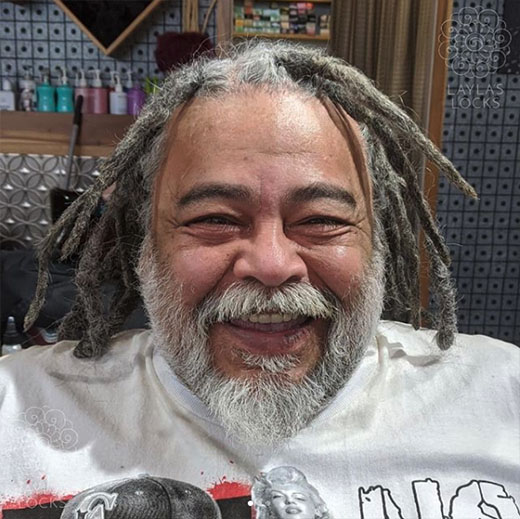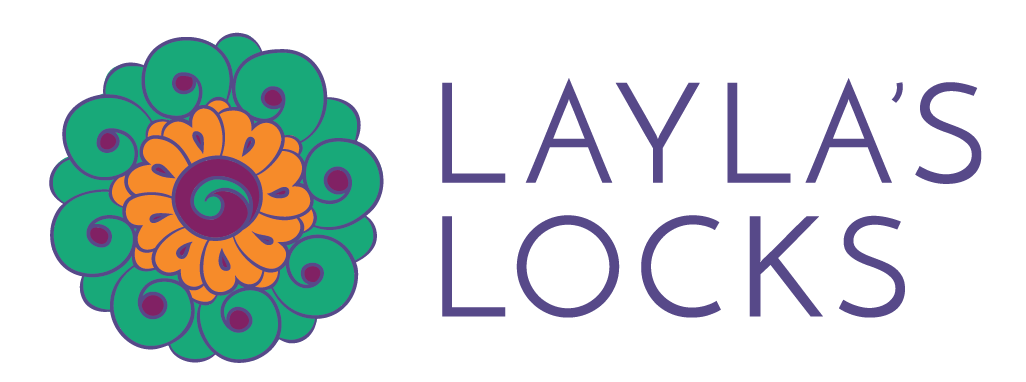Maintenance: The First Year
All forms of locs need maintenance to promote strong ropes of hair by incorporating loose hairs in the correct places, but more importantly, to cultivate a healthy scalp that remains clear of debris and grows strong healthy hair. I’ll describe some home care recommendations for each phase of your loc journey, but the most fundamental advice for all is WASH and SEPARATE!

The First 4-6 weeks
Your scalp will go through an adjustment period. You scalp is used to free moving hair that is washed and combed on a regular basis. After the initial backcombing process, it will feel confined, tight and itchy. You might notice small red bumps in the parting areas in particular. This is all normal and not cause for alarm. Your scalp is adjusting to your locs and as your hair grows and the roots naturally loosen, these problems will clear up, but may return to a lesser degree after routine maintenance.
DOUBLE Wash every 7-10 days with a residue free shampoo. Regular shampoos and soaps may leave conditioners and residues that will actually inhibit the formation of your locs, therefore, I recommend a loc specific shampoo. I use and sell Dollylocks on my own locs. Loc specific shampoo is really the best for proper cleansing and lock formation, and the cleaner your hair is, the better your locks will form. Focus your cleansing at the scalp, being sure to massage the entire surface thoroughly, even under each lock section, and carefully rinse the soap through the length of your baby dreads without too much agitation. I definitely recommend a double wash to get your scalp completely free of the buildup of dead skin cells and natural oils that will potentially become buildup inside your locs if you fail to cleanse your scalp completely. As a general rule, healthy scalp = healthy hair.
After each washing, your baby dreads will require some attention as early washing will cause them to fuzz out, conjoin, and scrunch up. After you towel dry them is a great time to apply gel, stretch and palm roll each individual loc, starting at the roots and working to the ends. You will want to alternate use of gel and tightening spray. Lock formation is created by friction from dry clean hair that is encouraged by the tightening spray, and compressed and held in place by gel. Both ingredients are recommended in these initial stages for optimum formation of well groomed locs, and a careful balance of the two will create ideal locking conditions. Both of these products are water soluble, and will wash completely out of the hair.
To maintain the length and wispiness of your locs, I recommend wet stretching; aka the process of pulling and smoothing out the loc from root to end. This is one of the remedies for loops and bumps, which are a natural part of the process and give your locs that organic appearance. To maintain loose ends, the hair must be brushed to keep it from locking up.
Try to avoid soaking your hair or swimming in the first 4-6 weeks (unless you are using a firmly fitting swimming cap). Complete submersion in water will loosen very new dreads and frequency of exposure to water will inhibit proper locking.
The First 6 Months to a Year
The time from backcombing and crochet to mature dreads varies greatly from person to person and it may take as little as 6 months to as much as a year for all your locks to fully mature, but in order of importance, here are some factors that will influence your results:
Maintenance, Maintenance, Maintenance… I cannot overemphasize the importance of your own input and work, especially in the early stages. Keep washing every 7 to 10 days to keep your scalp clean and promote locing. Always separate locs from roots to ends, and palm roll each newly separated section. Wash, separate, palm roll, repeat!
Thickness of the sections – The thicker the section, the quicker the lock will form, the smaller the sections, the more coaxing they will require.
The more hair in the section, the more overall knot formation will happen, thus creating a thicker and more solid network of hair at a faster rate. The thin, delicate dreads will take much longer to solidify and need lots of love and attention.
Hair Texture – Although this is a factor that predicts ease of locking, I put this at the bottom of the list because I believe that with dedication to good maintenance, anyone can have a great looking head of locs.
The other fundamental advice i have for the first year is to schedule routine maintenance. I recommend 4 times in the first year, once every three months, to keep the journey on track, and after that the frequency is up to you, but most people see me anywhere between 2-4 times per year.
